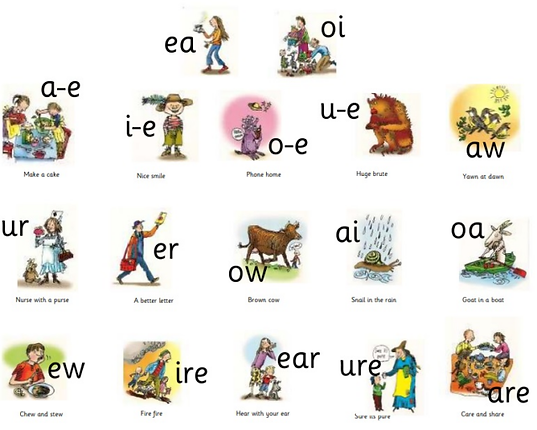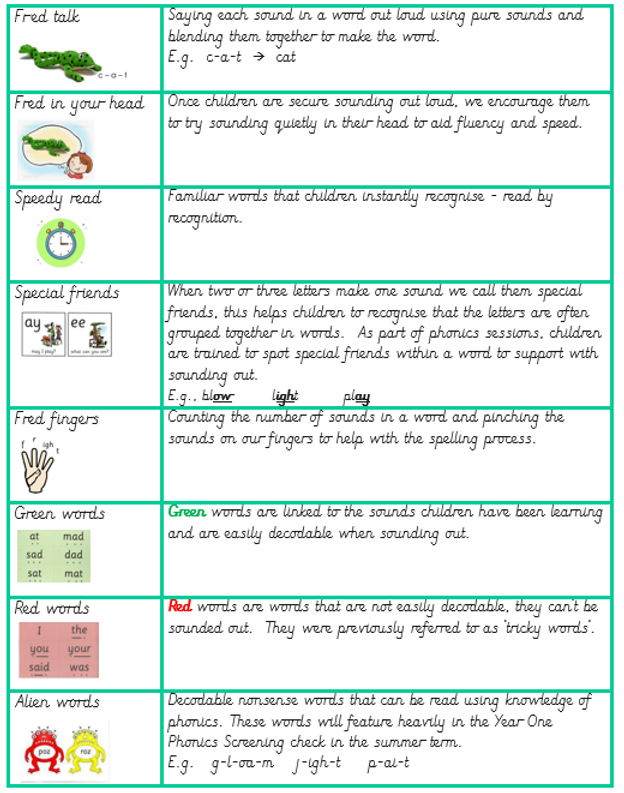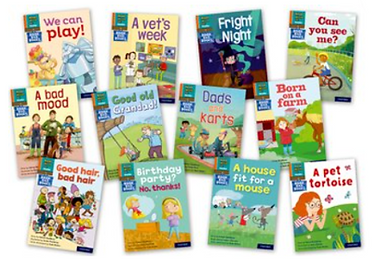Phonics
Dane Royd Readers
Sound, Blend, read
Welcome to our Read Write Inc. page!
I am Miss Hudson and I am the Phonics Lead in school.
I hope you find this page useful and a good source of information regarding what Phonics looks like at Dane Royd.


Intent - Why is early reading so important for our children?
Learning to read is one of the most important skills your child will learn in school. Everything else depends on it, so we put as much energy as we possibly can into making sure that every single child learns to read as quickly as possible. At Dane Royd we want all children to acquire the skills to decode, to establish a love of reading and ultimately to have the ability to read for themselves. This is why we put our efforts into making sure they develop a love of books as well as simply learning to read.
Implement - How will our children learn?
At Dane Royd we follow the Read Write Inc Phonics scheme to give your child the best possible start.
In EYFS and KS1, a systematic and rigorous approach to phonics is applied through the delivery of the Read, Write Inc. programme. Robust, half-termly assessments are used to ensure that children are making at least expected progress and are placed in a group that is matched to their ability. Where children are not making expected progress, 1:1 tutoring sessions are swiftly put in place to address this and support children to keep up, not catch up.
To begin with our children read sound cards and green word cards, once they are able to confidently decode, they progress onto books that are closely matched to their phonic knowledge. Once confidently decoding, children get the opportunity to take home a familiar text and an unfamiliar text to read at home, both of which match their increasing phonic knowledge.
In KS2, some children will continue to access RWI lessons. These children will continue to take home familiar and unfamiliar books that are closely matched to their phonic knowledge.
Staff delivering Read, Write Inc. lessons have access to quality training materials provided by the Ruth Miskin Portal to ensure that teaching is up to date, consistent and of a high standard.
What is Read, Write, Inc?
Read Write Inc (RWI) is a complete phonics and literacy programme which helps all children learn to read fluently so they can focus on developing their skills in comprehension and vocabulary. The programme is designed for children aged 4-7. However, at Dane Royd we begin to introduce the programme in Nursery and will continue teaching RWI to children as an intervention beyond the age of 7 if they still require support in their reading. RWI was developed by Ruth Miskin and more information on this can be found at https://ruthmiskin.com/en/find-out-more/parents/.
 |  |
|---|---|
 |  |
 |
Five key principles underpin the teaching in all Read Write Inc. sessions:
Purpose: know the purpose of every activity and share it with the children, so they know the one thing they should be thinking about
Participation: ensure every child participates throughout the lesson. Partnership work is fundamental to learning
Praise: ensure children are praised for effort and learning, not ability
Pace: teach at an effective pace and devote every moment to teaching and learning
Passion: be passionate about teaching so children can be engaged emotionally.
How will RWI be taught?
All children are assessed regularly by our RWI lead teacher so they are grouped with children at the same level. This allows lessons to be pitched at the correct level and ensures full participation.
Nursery
When appropriate, children will be introduced to the letter sounds and picture cues. They will be encouraged to use speaking and listening skills as they are immersed in a wide range of high quality stories.
Reception & Year 1
In Reception children will learn how to ‘read’ the sounds in words and how those sounds can be written down. They then access short age appropriate texts daily. In Year 1 children follow the same format as Reception but will work on complex/alternative sounds and read longer books appropriate to their reading level.

Learning to blend with Set 1 Speed Sounds
Your child is learning to read words containing Set 1 Speed Sounds by sound blending. For example:
m-a-t mat
c-a-t cat
g-o-t got
f-i-sh fish
s-p-o-t spotb-e-s-t best
s-p-l-a-sh splash

Set 2 Sounds
Your child will progress on to their Set 2 sounds.
These are the Set 2 sounds:
ay
ee
igh
ow (as in blow)
oo (as in zoo)
oo (as in look)
ar
or
air
ir
ou (as in out)
oy

Set 3 Sounds
ea (as in tea)
oi (as in spoil)
a–e (as in cake)
i–e (as in smile)
o–e (as in home)
u–e(as in huge)
aw (as in yawn)
are (as in care)
ur (as in nurse)
er (as in letter)
ow (as in brown)
ai (as in snail)
oa (as in goat)
ew (as in chew)
ire (as in fire)
ear (as in hear)
ure (as in pure)
Read, Write Inc Terminology
At school we use a puppet called Fred who is an expert on sounding out words!
The following video is an example of blending sounds with Fred. https://www.youtube.com/watch?v=dEzfpod5w_Q

Knowledge and Skills Progression Maps
Please note that knowledge and skill progression maps are available for parents/carers upon request, highlighting the learning journey in our school. However, we regret that publishing these maps online is not possible, as our school follows a purchased scheme of work. Please feel free to approach the school administration if you require further information regarding your child's progress in specific subjects.
Reading
The children:
-
Learn letter sounds and the corresponding letters using simple picture prompts
-
Learn to read words using Fred talk and sound blending
-
Read from a range of storybooks and non-fictions books matched to their phonic knowledge
-
Develop comprehension skills in stories by answering 'Find It' and 'Prove It' discussion questions
Writing
The children:
-
Learn to write and form the letters/letter groups which represent the 44 sounds with the help of fun phrases
-
Learn to write words by using Fred Talk and Fred Fingers
-
Learn to build sentences by practising sentences out loud before they write
Talking
The children:
-
Answer every question
-
Practise every activity with their partner
-
Take turns in talking and reading to each other
-
Develop ambitious vocabulary
Once children become fluent speedy readers the RWI session will be replaced with a standard English lesson.
Impact - What is achieved through our early reading curriculum?
By following the Read, Write, Inc programme our children feel confident in using their phonic knowledge and the skills that they have been taught to read and spell words. This helps them to access a range of texts and, in turn, promotes a love of reading. By taking home books that are both familiar and closely matched to their phonic knowledge, children can be successful in reading.
Based on 2022/2023 results:
In EYFS 87% reached ARE for word reading, compared to National outcomes at 75%. The children adopt the strategies and can be observed using their ‘Fred talk’ and ‘Fred finger’ skills independently in the continuous provision, and outcomes in Foundation create sound building blocks moving into KS1.
In Year 1 we have seen the success of the programme increase our Phonics Screening Check attainment to 95%.

The majority of Year 2 children have completed the RWI programme by the Autumn term and are able to move onto reading a range of texts in reading lessons and can access the rest of the curriculum confidently and with increasing independence.

What do our children like about RWI?
I can read by using Fred talk.
Madison, Year 1
My favourite sound is 'blow the snow' It is fun to say.
Tilly Year 1
Sometimes I have to Fred in my head, but I’m getting good at speedy reading now.
Heidi, Year 1
I like reading the alien words, they are funny!
Connor, Year 1

I know all the Set 2 and Set 3 special friends now.
Rohan, Year 1
To help at home:
Your child will start to bring books home when they are confident at reading the sounds they know. Please find time to listen to them read, have patience and give lots of praise!

We have a full range of new and engaging books to share at home.




